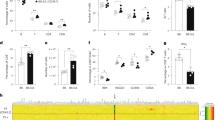Abstract
Cytochrome c is an indispensable electron carrier in the mitochondrial respiratory chain and also an important mediator of the internal pathway triggering apoptosis. Mice with a complete deficiency of the Cycs gene encoding the somatic cytochrome c die during the embryogenesis. Using the technology of LoxP-cre-dependent tissue-specific recombination, we obtained some mouse strains with significantly reduced expression of cytochrome c in certain cell types (“conditional genetic knockdown”). This knockdown was achieved by abrogation of the normal splicing of the Cycs locus pre-mRNA due to an additional acceptor site inside the stop-cassette neor. Previously, we observed embryonic lethality in homozygous mice with the same knockdown of cytochrome c in all cells of the organism. In the present work we studied two novel mouse strains with conditional knockdown of the Cycs gene in T lymphocytes and macrophages. Somewhat surprisingly, the mice of these two strains under normal conditions were not phenotypically different from the wild-type mice, either on the whole organism level or on the level of activity of individual target cells. Thus, the amount of cytochrome c in lymphomyeloid cells does not affect their development and normal functioning.
Similar content being viewed by others
References
Skulachev, V. P. (1998) Cytochrome c in the apoptotic and antioxidant cascades, FEBS Lett., 423, 275–280.
Hake, L. E., Kuemmerle, N., Hecht, N. B., Kozak, C. A., Zou, H., Li, Y., Liu, X., and Wang, X. (1994) The genes encoding the somatic and testis-specific isotypes of the mouse cytochrome c genes map to paralogous regions of chromosomes 6 and 2, Genomics, 20, 503–505.
Narisawa, S., Hecht, N. B., Goldberg, E., Boatright, K. M., Reed, J. C., and Millan, J. L. (2002) Testis-specific cytochrome c-null mice produce functional sperm but undergo early testicular atrophy, Mol. Cell Biol., 22, 5554–5562.
Li, K., Li, Y., Shelton, J. M., Richardson, J. A., Spencer, E., Chen, Z. J., Wang, X., and Williams, R. S. (2000) Cytochrome c deficiency causes embryonic lethality and attenuates stress-induced apoptosis, Cell, 101, 389–399.
King, M. P., and Attardi, G. (1989) Human cells lacking mtDNA: repopulation with exogenous mitochondria by complementation, Science, 246, 500–503.
Vempati, U. D., Han, X., and Moraes, C. T. (2009) Lack of cytochrome c in mouse fibroblasts disrupts assembly/stability of respiratory complexes I and IV, J. Biol. Chem., 284, 4383–4391.
Mansfield, K. D., Guzy, R. D., Pan, Y., Young, R. M., Cash, T. P., Schumacker, P. T., and Simon, M. C. (2005) Mitochondrial dysfunction resulting from loss of cytochrome c impairs cellular oxygen sensing and hypoxic HIF-alpha activation, Cell. Metab., 6, 393–399.
Sherman, F., Stewart, J. W., Jackson, M., Gilmore, R. A., and Parker, J. H. (1974) Mutants of yeast defective in iso-1-cytochrome c, Genetics, 77, 255–284.
Mufazalov, I. A., Kruglov, A. A., Efimov, G. A., Drutskaya, M. S., Penkov, D. N., Kuprash, D. V., and Nedospasov, S. A. (2011) Effects of mutation in the cytochrome c gene and of inhibitors of reactive oxygen species on the accelerated involution of the thymus in mice heterogeneous by the TNF/LT, Ros. Immunolog. Zh., 2, 112–120.
Mufazalov, I. A., Penkov, D. N., Chernyak, B. V., Pletyushkina, O. Yu., Vysokikh, M. Yu., Chertkova, R. V., Kirpichnikov, M. P., Dolgikh, D. A., Kuprash, D. V., Skulachev, V. P., and Nedospasov, S. A. (2009) Embryonal mouse fibroblasts with the K72W mutation in the gene of somatic cytochrome c: obtaining and characteristics, Mol. Biol. (Moscow), 43, 648–656.
Boltz-Nitulescu, G., Wiltschke, C., Holzinger, C., Fellinger, A., Scheiner, O., Gessl, A., and Forster, O. (1987) Differentiation of rat bone marrow cells into macrophages under the influence of mouse L929 cell supernatant, J. Leukoc. Biol., 41, 83–91.
Chomczynski, P., and Sacchi, N. (1987) Single-step method of RNA isolation by acid guanidinum thiocyanate-phenol-chloroform extraction, Anal. Biochem., 162, 156–159.
Livak, K. J., and Schmittgen, T. D. (2001) Analysis of relative gene expression data using real-time quantitative PCR and the 2ΔΔCT method, Methods, 25, 402–408.
Shilov, E. S., Mufazalov, I. A., Shebzukhov, Yu. V., Zvartsev, R. V., Drutskaya, M. S., and Nedospasov, S. A. (2013) Conditional genetic knockdown of the mouse somatic cytochrome c in lymphomyelid cells, Ros. Immunol. Zh., 4, 361–371.
Kulikov, A. V., Shilov, E. S., Mufazalov, I. A., Gogvadze, V., Nedospasov, S. A., and Zhivotovsky, B. (2012) Cytochrome c: the Achilles’ heel in apoptosis, Cell. Mol. Life Sci., 69, 1787–1797.
Imao, T., and Nagata, S. (2013) Apaf-1- and caspase-8-independent apoptosis, Cell Death Differ., 20, 343–352.
Dudkina, N. V., Kudryashev, M., Stahlberg, H., and Boekema, E. J. (2011) Interaction of complexes I, III, and IV within the bovine respirasome by single particle cryoelectron tomography, Proc. Natl. Acad. Sci. USA, 108, 15196–15200.
Tuominen, E. K., Wallace, C. J., and Kinnunen, P. K. (2002) Phospholipid-cytochrome c interaction: evidence for the extended lipid anchorage, J. Biol. Chem., 277, 8822–8826.
Sinibaldi, F., Howes, B. D., Piro, M. C., Polticelli, F., Bombelli, C., Ferri. T., Coletta, M., Smulevich, G., and Santucci, R. (2010) Extended cardiolipin anchorage to cytochrome c: a model for protein-mitochondrial membrane binding, J. Biol. Inorg. Chem., 15, 689–700.
Lapuente-Brun, E., Moreno-Loshuertos, R., Acin-Perez, R., Latorre-Pellicer, A., Colas, C., Balsa, E., Perales-Clemente, E., Quiros, P., Calvo, E., Rodriguez-Hernandez, M. A., Navas, P., Cruz, R., Carracedo, A., Lopez-Otin, C., Perez-Martos, A., Fernandez-Silva, P., Fernandez-Vizarra, E., and Enriquez, J. A. (2013) Supercomplex assembly determines electron flux in the mitochondrial electron transport chain, Science, 340, 1567–1570.
Author information
Authors and Affiliations
Corresponding authors
Additional information
Original Russian Text © E. S. Shilov, I. V. Kislyakov, E. A. Gorshkova, R. V. Zvartsev, M. S. Drutskaya, I. A. Mufazalov, V. P. Skulachev, S. A. Nedospasov, 2014, published in Biokhimiya, 2014, Vol. 79, No. 12, pp. 1724–1736.
Rights and permissions
About this article
Cite this article
Shilov, E.S., Kislyakov, I.V., Gorshkova, E.A. et al. Mouse lymphomyeloid cells can function with significantly decreased expression levels of cytochrome c . Biochemistry Moscow 79, 1412–1422 (2014). https://doi.org/10.1134/S0006297914120177
Received:
Published:
Issue Date:
DOI: https://doi.org/10.1134/S0006297914120177




